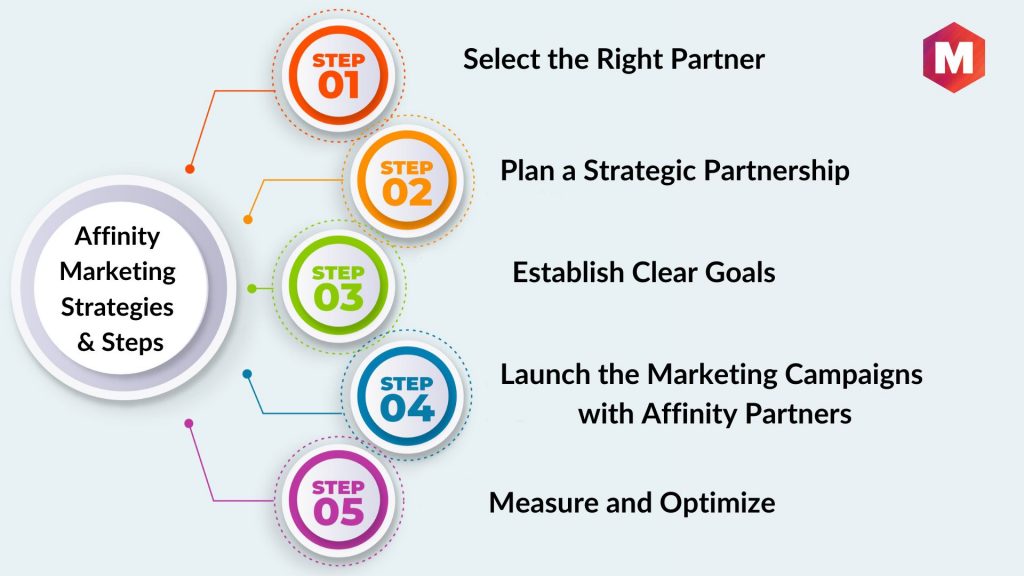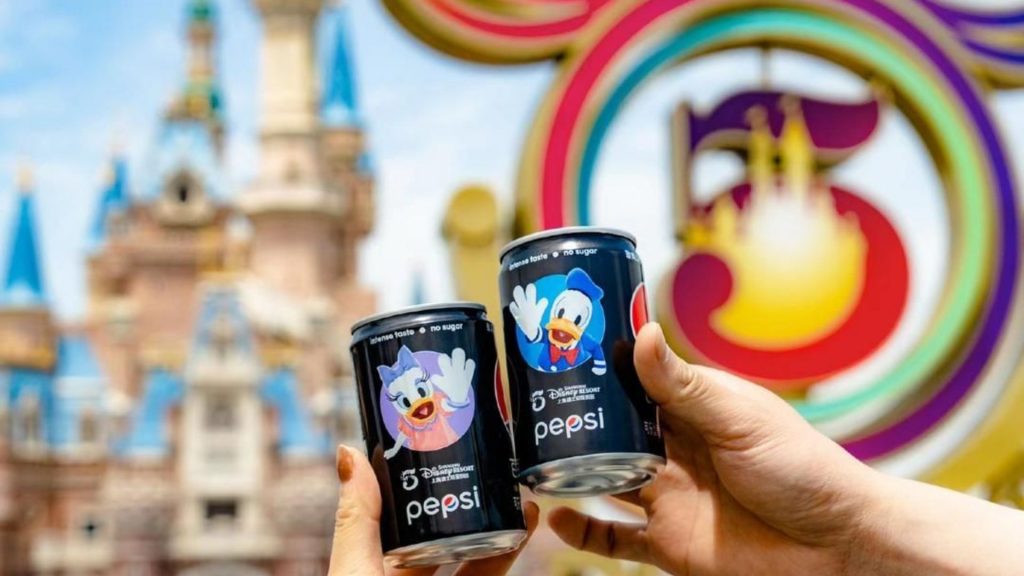Affinity marketing is an integral part of a solid and successful marketing strategy. This is when two or more businesses work together to promote their brands to as many people as possible. Because they work together, they can give their customers a more comprehensive range of goods and services, which helps both of them make more money.
The main goal of an effective affinity marketing strategy is to make both brands more well-known and visible while also building a solid connection between them. Thanks to the partnership, both businesses can offer their customers a more extensive range of goods and services.
Table of Contents
What is Affinity Marketing?

Affinity marketing partners with another group to promote a company’s products and services to new or existing customers.
An affinity campaign involves a business selling a product or service to an affinity group of people who desire the same thing. These people help each other out.
In addition to “affinity marketing,” we use “strategic collaborations” with brands that provide similar or suitable products and wish to raise awareness. Collaboration increases audience size, which benefits both sides.
However, affinity marketing is not confined to two categories. Any number of companies in the same affinity group can benefit each other. Affinity groups let companies of various sizes collaborate on projects. Small cafeterias or large financial institutions or credit card corporations might be in many fields.
A sports team wearing name-branded apparel is an example of affinity marketing. Sponsors and money enable sports teams to buy better gear and spend more. The logos help customers remember their brand, and the cooperation can boost their business.
Similarly, look at any travel portal. You will see it as an affinity group wherein various people collaborate, such as travel agents, hotels, airlines, railways, food suppliers, local travel coordinators, etc.
Moreover, affinity group members subscribe to a large category and can vary from individuals to organizational entities. This means that shareholders, fans of a sports club, employers, employees, or even customers can be included in this group.
Origin of Affinity Marketing Concepts
In 1992, Macchiette and Roy developed affinity marketing, which blends affinity and marketing.
According to them, affinity is “a person’s level of cohesiveness, social bonding, identification, and conformity to the norms and standards of a particular reference group.” On the other hand, marketing is “the expectation of benefit for the individual satisfying consumer wants and needs.”
People have an emotional connection with a particular brand or group. This is called brand loyalty or affinity. One brand can use this connection and customer engagement to help itself by building an affinity partnership.
Why use Affinity Marketing?
It is clear why affinity marketing is essential, especially in today’s challenging business world.
1. Referral systems can help you gain customers’ trust
Trust-bridge that works: Setting up rules and methods for customer referrals can help you build trust with your customers. Let us look at the case of a fashion business that cares about the environment. Green-conscious customers are more likely to trust programs that link promotion rewards to environmental causes.
2. Making heroes of your brand
Building relationships with influential people in the community, like a fitness center contacting local health buffs to support wellness programs, can help spread the word about a brand.
3. Making mutual value
Negotiating marketing partnerships that are good for both parties, like two software companies grouping their products to save money, increases brand exposure, and creates shared benefits.
4. Strengthen your credibility
Getting support from well-known groups, like a new tech startup getting support from a prominent tech forum, boosts credibility and customer trust.
5. Targeting with accuracy
Grouping marketing efforts into specific niches lets companies target them more precisely, like when an automaker promotes an off-road feature just for adventure fans.
6. Use relationships you already have
Cross-selling products to current customers, like a skincare brand offering a new anti-aging line to its regulars, increases the customer’s lifetime value by building on the relationships already made.
Benefits of affinity marketing
Affinity marketing, a strategic partnership between brands or companies with similar values, is perfect for businesses. Let us look at them:
1. New Customer Acquisition
Another efficient technique for finding new customers is to use affinity relationships with various consumers. For example, a fitness clothing manufacturer might partner with a famous social media fitness influencer. This may entice fitness fanatics to try and buy the brand’s items. This relationship helps the firm gain a new market of customers by exploiting a current, interested audience and attracting new, long-term clients.
2. Cross-Sector Opportunities
Businesses outside of the industry can form affinity alliances. For example, a clothes retail chain may partner with a popular music streaming service to offer discounts or early access to shows. Even if these organizations do not compete for customers, affinity relationships can help them collaborate, attract new customers, and increase sales and customer engagement.
3. Building trust
Marketing is about trust-building. Customers trust a brand’s product, service, or mission. Customers will trust your brand more if it is affiliated with a trustworthy company. Consider a university buying stationery from an eco-friendly brand. Both parties benefit from this collaboration. The eco-friendly brand can help the university reach more people and inspire other academics to go green.
4. Increasing Brand Awareness
Affinity marketing spreads a brand’s values and vision. When a sustainable clothing business partners with a nonprofit that plants trees, it shows its environmental concern and benefits the nonprofit. This mutually beneficial partnership can create brand recognition and attract customers who share environmental ideals by connecting environmentalists with the brand.
Features of Affinity Marketing
A robust marketing method called affinity marketing is based on three main ideas: the endorsement of a third party, the concept of sharing incentives, and the enhancement package. This unique way of marketing comprises these three bases that work together.
1. Endorsement of Third-Party
In affinity marketing, this aspect is likened to a trusted friend recommending a product or service; it holds an honest, reliable vibe. When the leaders of an affinity group support a product, that support is shared with the group members through focused emails or unique posts on the group’s social media sites and newsletters. Think about a university alum association (the affinity group in this case) endorsing a famous job site just for its members. Because the people in the affinity group value the advice of their leaders, it makes it more likely that they will choose the suggested job site.
2. Concept of Shared Incentives
Shared incentives are the glue that binds an affinity group. People in a group work together to reach a common goal, and they often promote services or goods that help them achieve their goal. Imagine a group of people who care about the environment getting together to push devices that use less electricity or products that last longer. In this case, shared incentives are not just about protecting the environment; they also help move goods that align with their cause.
3. The Enhancement Package
This feature is about giving the customer a basket of carefully chosen perks to meet their needs. Companies generally must first determine if customers are interested in the product idea. A bike club could be an affinity group. They would like a product that discounts bike gear, fitness coaching, and maintenance services. Putting all these benefits together can raise the product’s value and make it more appealing. Members of the affinity group can use this product just like anyone else in the customer market.
Examples
An affinity marketing example can be an Athletic apparel company that partners with running shoe companies to offer discounts on their products to customers who purchase athletic apparel from the apparel company.
Another example is Ford Motor Company’s partnership with the National Park Foundation to benefit Rosie the Riveter/WWII Home Front National Historical Park in Richmond, CA.
Some of the other examples of business-driven partnerships can be –
- Automotive companies partner with travel companies to offer discounts on their products to those who book travel through the travel company
- Restaurants partner with travel companies to provide discounts on their products to travelers who book trips through the travel company
Companies can also partner with a company in the same industry but with a different target market. For example, in an affinity marketing partnership, a restaurant may team up with a wine producer to offer discounts on their products to customers who purchase meals at the restaurant.
Tips for implementing affinity marketing
To make an affinity marketing plan work, you need to know a lot about your competitors and think carefully about what your customers want. Here is a list of essential things you should know to make affinity marketing work:
1. Be Patient
With affinity marketing, you work with customers over time to build stronger ties and find new ones. Getting customers related to your affinity partner to stick with you might take some time, so it is essential to be patient and plan for long-term success.
2. Focus on the Customer
A successful affinity marketing strategy is based on what customers want and how they act. Monitor your customers’ engagement closely and conduct a market study to discover what motivates them to engage. By using customer behavior and learning about what customers want, you can ensure that your goods and services meet their needs.
3. Maintain Your Partnership
For affinity marketing partnerships to work, you and your affinity partner must have a connection that benefits both of you. To keep this connection strong, set up regular ways to talk, hold status meetings, share technology and resources, and trade helpful business information. Partnerships where people work together can be perfect for both sides.
4. Be Flexible
When you work with a relationship marketing partner, you may need to change how you usually do things to ensure they work well together. Set straightforward jobs and goals so that each company can focus on what it does best. Check-in regularly to see if your goals are being met, and be ready to make changes as needed to improve performance and ensure your goals align with those of your partner.
Affinity Marketing Steps & Best Practices
Here are five steps you can take to start your affinity marketing projects and get the most out of your marketing teams and skills.
1. Select the Right Affinity Partner
Picking the right partner for your relationship marketing plan is crucial to its success. You want to find a partner who fits your brand’s image and the people who buy from you. The partner should also offer the goods and services that your audience wants.
2. Plan a Strategic Partnership
It is time to figure out how you want to work together once you have chosen your partner. Consider what you can give each other regarding finances, benefits, and other help. After that, make a detailed plan for using this partnership marketing approach.
3. Establish Clear Goals
You need to know some things about your strategy before you start running it. Do you want more people to know about your brand? Make more sales? Boost the number of leads that your website brings in. Make sure you can measure your goal, no matter what it is, to see when the plan is working.
4. Launch the Marketing Campaigns with Affinity Partners
It is time to start your campaign once you know your goals! It is helpful if you have a good relationship with your membership organizations or brand partner. They can help you figure out the best ways to sell your products or services through their channels (like social media) or at events their members regularly attend.
5. Measure and Optimize
Do not expect results immediately from affinity marketing because it is an ongoing process. Instead, keep track of the metrics that matter most to your business (using partner relationship management software) and regularly measure your progress. For example, the number of leads generated or the conversion rate (the percentage of people who finish an action). Now that you know this, change your plan to make it work best for your business goals!
How to improve ROI with Affinity Marketing?
For better return on investment (ROI) with relationship marketing, do these essential things:
- Hire affinity marketing professionals: To ensure the success of your efforts, seek help from people knowledgeable about community marketing and partnership programs.
- Select the Right Partners: If you want your affinity marketing to work, you should look for partnerships with companies whose values are similar to yours and whose target audiences are similar to yours.
- Ensure Mutual Benefits: Create partnership deals that are good for everyone, focusing on equal participation and working together to maximize the opportunity for success.
- Develop a Comprehensive Affinity Program: Together, set up a structured affinity program with scalable technology, transparent terms, and rules that all partners must follow.
- Monitor and Adapt: Regular monitoring of the program’s progress will enable the affinity group to adapt and optimize their strategies, ensuring the marketing campaigns yield the best possible results.
Affinity Marketing vs. Co-Branding vs Cause Marketing Strategy
Affinity marketing is when a brand partners with another brand with a similar target audience. For example, if you were selling camping equipment, you might partner with REI, which specializes in outdoor gear.
Co-branding is when two companies come together to create something new. For example, Pepsi might partner with Disney to create a co-branded soda called “Pepsi-Mickey Mouse Soda.” Co-branding is most successful when both partners bring something unique to the table—for example, a type of product that one partner provides. Still, the others do not (like Pepsi providing the soda and Disney providing the branding).
Cause marketing involves partnering with non-profit organizations to support a cause related to their work. This can be done in several ways, including donating money or making product donations, providing discounts for people who donate to nonprofits, or simply encouraging customers to donate when they purchase your product.
Who employs Affinity Marketing campaigns?
Many different businesses and affinity groups use affinity marketing efforts to collaborate in ways that benefit both sides. So, who are the prominent people who participate in relationship marketing?
Affinity groups that take part in these efforts may include:
- Trade groups and professional clubs
- Charity work and non-governmental groups (NGOs)
- Some businesses cater to specific groups of people.
Business-wise, relationship marketing has a few best ways to be done. In addition to the ones listed above, these relationships can be found in companies of all sizes, types, and products. To show this, here is a list of companies that use relationship marketing all the time:
- The big flight companies
- Hotels and resorts in chains
- Institutions of Finance
- Big store groups, like department stores and supermarkets
- Global clothing brands
- Companies that sell and handle real estate
- Fuel stations
While these examples are a good starting point, it is essential to remember that affinity marketing has a lot of different situations. Businesses can develop new ways to form affinity relationships that meet the needs same interests of both parties if they do a lot of research and analysis.
What kinds of customers are effectively marketed to in Affinity Marketing campaigns?
Successful Affinity Marketing campaigns depend on targeting and engaging the right customers. It is crucial to understand that various consumer segments need personalized, value-driven tactics tailored to their interests and demands.
Organization Members: These campaigns often profit from affinity groups from established organizations. Take the American Automobile Association to illustrate. AAA provides millions of Americans with roadside help, travel benefits, and more. Goodyear Tires could benefit from a strategy focused on this demographic. Due to the high potential of this target market, Goodyear may work with AAA to offer members unique tire reductions and safety checks.
Loyalty Program Participants: These customers already like the brand. Starbucks Rewards is an unusual example. By working with an eco-friendly tumbler business like Klean Kanteen, they may offer members cheap reusable tumblers, combining loyalty, sustainability, and shared customer values.
Professional associations: Affinity marketing works well for them. Microsoft, for instance, may target ACM members. This gives ACM members preferential access to Microsoft’s latest products and offers Microsoft a highly relevant customer base.
Targeting these groups requires more than identification. As your business enters affinity marketing, you must build strong, mutually beneficial agreements that are carefully negotiated and implemented. A successful affinity marketing campaign requires research, networking, strategy, and careful negotiation to form valuable partnerships.
What career titles work with Affinity Marketing strategies?
Success in Affinity Marketing techniques depends on numerous roles. These specialists use their knowledge of these tactics to develop strong strategic partnerships and engage customers. Career titles that use affinity marketing tactics include:
Director of Marketing: Like Marketing Managers, Marketing Directors identify affinity groups that fit a company’s product or service. Their primary focus is identifying market wants and matching product offerings to affinity groups.
Campaign Coordinators: Campaign Coordinators assist Marketing Directors as Promotional Managers. Their main job is to create attractive offer packages that benefit the firm and affinity group.
Marketing Consultants: Like Marketing Specialists, Marketing Consultants advise businesses on various marketing techniques. They create and implement Affinity Marketing plans to increase brand awareness and consumer loyalty among affinity groups.
A Marketing Director could use these occupational titles to identify fitness enthusiasts as a sportswear brand affinity group. The Campaign Coordinator created customized promotions, like discounted gym memberships with every transaction. Finally, a Marketing Consultant would suggest working with famous fitness clubs or sponsoring local fitness events to accomplish this plan.
Each job title’s responsibilities and contributions may vary depending on the company’s size, industry, and marketing goals.
Conclusion!
Affinity marketing is a type of direct marketing that involves a mutually beneficial partnership between two brands. The relationship can be based on similar values, shared interests, or even a simple appreciation for each other’s products and services that can lead to a more profitable customer base.
When used strategically, affinity marketing helps build strong customer relationships, increase customer loyalty, and attract potential customers.
Liked this post? Check out the complete series on Marketing




can you please describe the legal obligations of a business